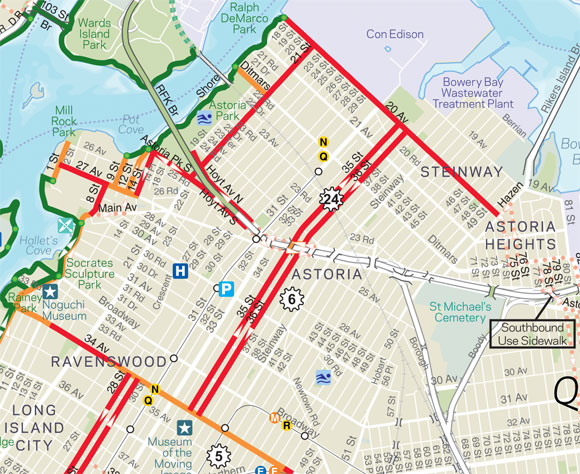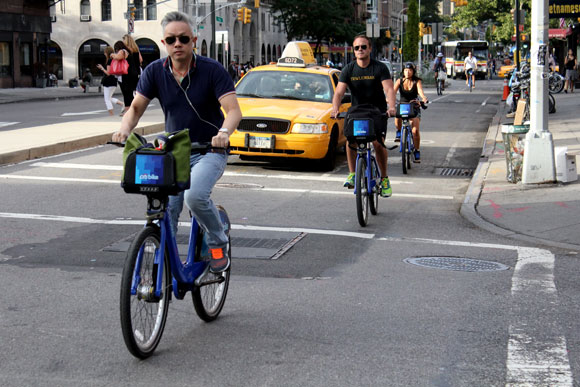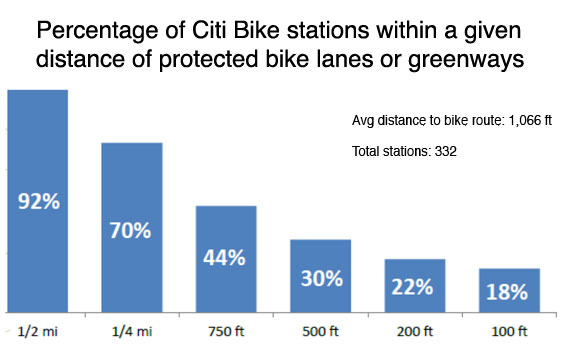This is part two of a five-part series by former NYC DOT policy director Jon Orcutt about the de Blasio administration's opportunities to expand and improve cycling in New York. Read part one here.
The pending expansion of Citi Bike to at least 12,000 bikes is an obvious reference point for further bike network development (if the city and other parties can show the urgency and leadership to close the deal -- they have been said to be "close" since June).
The initial Citi Bike launch provided an impetus for substantial cycling improvements in Midtown during 2012 and 2013, as well as projects that anticipated expansion of the bike-share system, like the two-way bike lane on the 72nd Street route across Central Park. These plans sailed through their respective community boards because the bike-share/bike lane dynamic seemed so obvious it went virtually undebated.
Citi Bike would not have been adopted so abruptly by so many New Yorkers without extensive development of the bike lane network within the Manhattan central business district and nearby parts of Brooklyn from 2007 to 2012. A recent observational study of Manhattan cyclists concluded that "bike-share riders display a greater tendency to ride on more 'secure' street or avenue environments than their general cycling counterparts" (Bike Lanes + Bike Share Program = Bike Safety, Hunter College Sociology and Planning Departments, 2013).
The new Citi Bike plan will extend the station network north to mid-Harlem in the vicinity of 140th Street, encompassing the entire Upper East Side and Upper West Side as well, and expand both south into Brooklyn and north from the Williamsburg Bridge to the North Side of Williamsburg, Greenpoint, Long Island City, and Astoria.
While some of these areas, mainly in Brooklyn, already enjoy dense parts of the cycling network, the coming of Citi Bike should spur creation of more protected bike lane capacity on the Upper East and West Sides. In particular, the city should implement a protected lane between 60th and 100th Streets on Second Avenue as soon as subway construction wraps up, connect the Columbus Avenue lane to Ninth Avenue, and develop northbound protected routes on the Upper West Side. Additional east/west bike capacity could be linked to the cross-park routes like 72nd and 102nd Streets, likely to be heavily used by Citi Bike riders.
In Harlem, the bike network is missing links between the West Side path and the 125th Street area, and it lacks east-west routes north of 120th Street. St. Nicholas Avenue and Adam Clayton Powell Boulevard provide good spines for developing denser networks, though the Columbia University area is disconnected from these topographically and thus far represents a void in the bike network.

Long Island City's bike network is still developing, and Citi Bike expansion will push it to mature. Astoria, meanwhile, needs east/west bike routes north of 34th Avenue, especially to help with Citi Bike access to and from N/Q subway stations and the waterfront, Steinway Street and blocks to the east. Another north/south set of routes east of Steinway would improve bike circulation and routing throughout the district.
A capacity problem is already developing on the Queensboro Bridge bike and pedestrian path -- the bridge's north outer roadway. Unlike the Manhattan and Williamsburg Bridges, which clearly separate people on foot from people on bikes, the increasingly busy Queensboro path is shared between pedestrians and cyclists who have to use a too-narrow two-way bike path. West-bound cyclists continually pass one another because of the long climb from Queens Plaza, making it an even tighter fit. Citi Bike, bike network expansion, and demographic change in western Queens will exacerbate the problem and lead to more collisions. The answer is to convert the bridge's south outer roadway, which has served as the bike/foot path in the past, to non-motorized use so walkers and cyclists get a full lane each.
Coming up in part three tomorrow: A look at how the areas of New York most ripe for bike network development overlap with Bill de Blasio's campaign themes.







